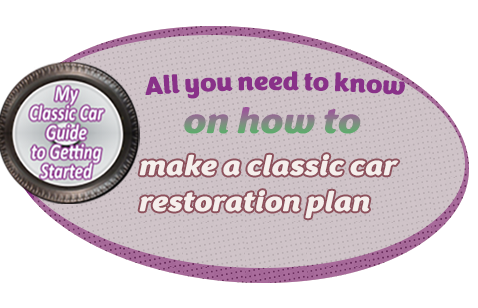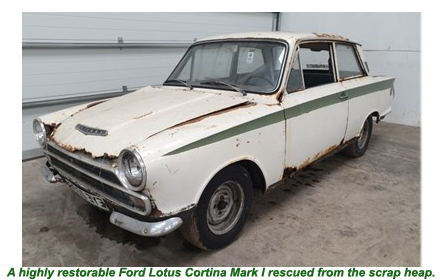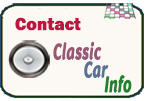 Once the decision has been made to take on a classic car restoration project, the obvious first step is to find a car to restore. Most restorers will have a particular make of model in their sights and may well have been on the lookout for years.
Once the decision has been made to take on a classic car restoration project, the obvious first step is to find a car to restore. Most restorers will have a particular make of model in their sights and may well have been on the lookout for years.
 There are even a few who have bought a vehicle earmarked for restoration and keep it on mothballs for years- while there are a very luck few whow have been gifted a vehicle from an elederly relative.
There are even a few who have bought a vehicle earmarked for restoration and keep it on mothballs for years- while there are a very luck few whow have been gifted a vehicle from an elederly relative.
 Some even have some of the facilities as well as the vehicle in place and ready to go for months if not years till the right conditions present themselves to get started.
Some even have some of the facilities as well as the vehicle in place and ready to go for months if not years till the right conditions present themselves to get started.
 When the time comes to rise up out of the armchair or any other comfort zone, the beginner restorer soon discovers that finding a classic car to restore means a lot of effort and determination. Travelling to car auctions and classic car shows is almost a necessary evil and an invaluable learning experience.
Choosing a first classic car for restoration needs a great deal of care and thought, although it does help to firmly preconceived ideas of the make and model that they dream of returning to its golden years.
When the time comes to rise up out of the armchair or any other comfort zone, the beginner restorer soon discovers that finding a classic car to restore means a lot of effort and determination. Travelling to car auctions and classic car shows is almost a necessary evil and an invaluable learning experience.
Choosing a first classic car for restoration needs a great deal of care and thought, although it does help to firmly preconceived ideas of the make and model that they dream of returning to its golden years.
 Beginner restorers who have no particular loyalty to a specific model or manufacturers leave themselves with a lot more options, although to save time and effort, it is most logical to narrow down the list of target vehicles, balancing between budget and personal preferences.
Beginner restorers who have no particular loyalty to a specific model or manufacturers leave themselves with a lot more options, although to save time and effort, it is most logical to narrow down the list of target vehicles, balancing between budget and personal preferences.
 Even before the search begins, a basic plan needs to be worked for the project; Finances need to be analysed carefully, allowing for an accurate budget to be drawn up covering all aspects of the project.
Any restoration budget has to consider buying the car, renting a workshop, investing in tools and equipment -making sure to leave as large a margin for error as possible.
Early cost projections can only be estimated as the final budget can only be prepared when the car is home, and the full extent of its condition is assessed. Even then, there inevitably be surprises once the actual restoration gets underway.
To reduce the risk element, finding a classic in reasonable condition that needs at most just partial renovation is the easiest but usually the most expensive alternative. Finding a fifty or sixty-year-old car that is still a runner is highly unusual but not impossible.
Even before the search begins, a basic plan needs to be worked for the project; Finances need to be analysed carefully, allowing for an accurate budget to be drawn up covering all aspects of the project.
Any restoration budget has to consider buying the car, renting a workshop, investing in tools and equipment -making sure to leave as large a margin for error as possible.
Early cost projections can only be estimated as the final budget can only be prepared when the car is home, and the full extent of its condition is assessed. Even then, there inevitably be surprises once the actual restoration gets underway.
To reduce the risk element, finding a classic in reasonable condition that needs at most just partial renovation is the easiest but usually the most expensive alternative. Finding a fifty or sixty-year-old car that is still a runner is highly unusual but not impossible.
 That’s the reason why most first-time restorers prefer to buy privately rather than at an auction.
With a few exceptions, bidding action at classic car auctions is very rapid, and mistakes can be made if impulsive decisions are made. The more reputable classic car auction companies offer an open day before the auction starts, with a few even allowing rudimentary checks to be carried out on the vehicle under supervision.
That’s the reason why most first-time restorers prefer to buy privately rather than at an auction.
With a few exceptions, bidding action at classic car auctions is very rapid, and mistakes can be made if impulsive decisions are made. The more reputable classic car auction companies offer an open day before the auction starts, with a few even allowing rudimentary checks to be carried out on the vehicle under supervision.
 Auctions are in general only for the brave-hearted and the experienced, which is why most beginner restorers are well-advised to buy either from a dealer or privately.
In both cases, they will have ample time to check out the vehicle before what will probably be a significant investment,
Restorers must never allow thmselves to forget that each classic car has been on the road probably for decades and and mechanically and bodily is in a unique condition.
Auctions are in general only for the brave-hearted and the experienced, which is why most beginner restorers are well-advised to buy either from a dealer or privately.
In both cases, they will have ample time to check out the vehicle before what will probably be a significant investment,
Restorers must never allow thmselves to forget that each classic car has been on the road probably for decades and and mechanically and bodily is in a unique condition. Back to the homepage- and don't spare the horsepower.

